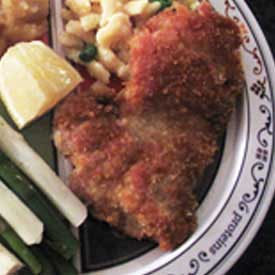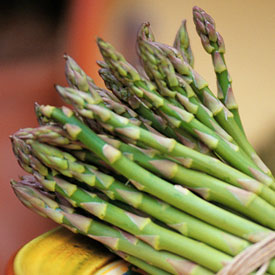German

Introduction to German Cooking
Traditionally, Germans enjoy eating hearty meals. This has a lot to do with the cool northern European climate and large supply of meat in the country. Years ago, hard-working Germans needed to eat foods high in calories and nutrients to stay warm while working outside in cold weather. This German diet is similar to the old-fashioned American “Meat and Potatoes” diet, because many German immigrants settled in colder climates of America. Germany, like America, is working hard to combat an increasing obesity problem. Since they they don’t work outside in the cold anymore (or at least, not as much). Germans are learning they can still enjoy traditional favorites only in smaller portions. Health conscious Germans also include more vegetables, fruits and whole grains in their meals. Like many countries, German food varies by region. The northern region’s specialties include pickled, smoked, and fresh fish because they are so close to the North and Baltic seas. In the central region, you will find wild game, sausages, and a variety of vegetables because this area has fertile soil for growing crops and grazing, and forests for hunting wild game. The southern area is the home to dumplings, breads, sweets and a variety of meat dishes. The famous Bavarian pretzel comes from the southern state of Bavaria. Eating local is a way of life in Germany, the styles of cooking and preserving foods comes from using local resources wisely.
Guide to German Foods
Asparagus – Asparagus grows in every region of Germany and the locals love it so much they nickname it Königsgemüse, which means “King’s Vegetable” and Frühlingswonne, which means “Springtime Delight”.
Kohlrabi – A kohlrabi is a cross between a cabbage and a turnip. Germany is the world’s largest producer and consumer of kohlrabi. Kohlrabi taste like a broccoli stem, but sweeter. In the US, Kohlrabi is available from May to December and comes in both white (which is actually green) and purple varieties.
Sauerkraut – Sauerkraut is made by fermenting sliced green cabbage. Sauerkraut can be eaten raw or cooked. It is very high in Vitamin C and aids in digestion.
Wurst – Cold cuts and sausages are called wurst. The wurst was created as a way to preserve and store meat. There are over 1500 varieties of wurst. The most widely known are Bratwurst, Weisswurst and Frankfurter (a.k.a. hot dog).
Sauerbraten – Sauerbraten is a roast made with marinated beef or venison. The marinade is made with vinegar, wine, vegetables and spices. The meat is marinated for 3 to 4 days before cooking which makes it very tender and juicy.
Weiner Schnitzel – A Wiener Schnitzel is a pan-fried veal cutlet that has been breaded using flour, egg and bread crumbs. Fresh lemon is squeezed over the cutlet before serving. This dish can also be made using pork, turkey or chicken.
Spätzel – Spätzel is a German pasta dish made using flour, eggs, water and salt.The dough is cut or pressed to form small strips. Like pasta, it can purchased dry and is boiled to cook it.
Strudel – Strudels are pastries filled with fruits, vegetables, or meats. The most popular strudel is Apple Strudel. The name “Strudel” means whirlpool because the rolled dough looks like a whirlpool.
Butterbrot – Butterbrot is a slice of bread (brot) with butter. This is the basic start of many German meals. Butterbrot is topped with fruit spreads for breakfast and cheese, wurst or vegetables for snacks. Germans love their bread. In fact Germany produces more breads than any other country. The most popular varieties of German breads include rye, whole grain, multi-grain, sunflower and pumpkin.
Kinder-Kohlrabi-Potato Puree
Kohlrabi tastes similar to the stems of broccoli. When choosing kohlrabi at the market, look for kohlrabi bulbs that are about 2½ inches in diameter. Any larger and the skin may be tough and the insides can be woody.

Ingredients:
• 2 medium russet potatoes
• 2 kohlrabi bulbs (about 2-1/2 inch wide each)
• 1/4 medium onion, chopped
• 6 medium button mushrooms, sliced
• 1 Tbsp. olive oil
• Pinch of salt and pepper
• 1/2 cup vegetable or chicken stock
Preparation:
Wash, peel and cut potatoes into 1-inch chunks. Remove leaves and stems from Kohlrabi bulbs, wash, peel and cut them into 1-inch chunks
Bring a pot of lightly salted water to a boil and add potato and kohlrabi chunks. Reduce heat and simmer until tender, about 15-20 minutes. To check if they are done, a fork should slide through the pieces easily. Meanwhile, heat olive oil in a skillet. Add onion, mushrooms and a pinch of salt and pepper. Sauté over medium-low heat until softened, about 3-5 minutes. Remove from heat.
Drain potato and kohlrabi and place in a food processor or blender. Add soup stock and puree until smooth, adding more or less liquid to achieve desired consistency. Salt and pepper to taste.
Spoon the mixture into So Easy Storage Trays, Cover and Freeze.
To serve: Defrost cubes and warm slightly.
Toddler Treat: Kartoffelpuffer und Apfelmus
Potato pancakes and applesauce are an authentic German treat and will make a delicious meal for your little ones.
Potato Pancakes (Kartoffelpuffer)

Ingredients:
• 2 medium Russet potatoes
• 2-3 scallions, thinly sliced
• 1 egg
• 2 Tbsp. flour
• 4 Tbsp. vegetable oil
• ¼ tsp of each salt and pepper
• Dash of nutmeg
• Perfect Applesauce (recipe below)
Preparation:
Wash, peel and grate potatoes (for grating use a box grater or a food processor). In a medium sized mixing bowl, beat the egg, scallions, flour, salt, pepper, nutmeg and egg. Add potatoes and mix thoroughly.
Pour oil into a large, frying pan. The oil should cover the bottom of the pan about 1/8-inch deep. Heat oil on medium high heat. Using about 1/3 cup, drop the potato mixture into hot oil and flatten with the back of a spoon. Fry 3 minutes on each side, or until golden brown. Drain on paper towels and keep warm in low oven until serving time. Repeat until all potato mixture is used.
Makes about 8 potato pancakes. Serve warm with applesauce (recipe below).
Perfect Applesauce (Apfelmus)

Ingredients:
• 4 cooking apples (such as Golden Delicious, Granny Smith or McIntosh)
• 2 Tbsp. butter or margarine
• 1/3 cup water
• ¼ cup sugar
• ¼ tsp. cinnamon
Directions:
1. Wash, peel, and remove the core from the apples
2. Place apples, butter, sugar, water and cinnamon in a heavy pan.
3. Cook on low heat until apples are soft and mushy, about 25-30 minutes.
Makes about 3 cups, 6 servings
Octoberfest Family Meal

Menu
Weiner Schnitzel
Spätzel
Steamed White & Green Asparagus
Applesauce (recipe above)
Weiner Schnitzel Recipe

Ingredients:
• 4-6 chicken thighs, skinless and boneless
• Sprinkle of salt and pepper
• 1 egg, beaten
• 1 Tbsp water
• 1 cup plain breadcrumbs
• 3-4 Tbsp. vegetable oil
• Lemon wedges, for serving
Directions:
Place each chicken thigh between two pieces of plastic and pound the meat until it is very thin. Pour oil into a large skillet. The oil should completely cover the bottom of the pan and be about 1/8-inch deep. Heat the skillet with the oil on medium-high heat.
While the oil is heating in the pan, season the chicken with salt and pepper. Set up 2 shallow pans or bowls for breading the chicken. In the first dish, beat the egg and water together. In the second dish, add the breadcrumbs. Dip both sides of each chicken piece in the egg and drag each piece through the breadcrumbs.
Carefully place the coated cutlets into the hot oil to cook. Since they are so thin, the chicken will cook quickly, about 3 minutes per side. When both sides are nicely browned, place the pieces on a paper towel lined plate. Place in a warm oven until serving. Serve with lemon wedges.
Spätzel
Like pasta, Spätzel is also available dried and is prepared by boiling it. You can find it in the European foods section or pasta section of your super market. Simply follow the package directions. After the Spätzel has drained, place it back in the pan and sauté it with 2 Tbsp. butter and 3-4 sliced scallions.
If you are ambitious, you can make Spätzel at home. Here is a link to a recipe that provides good instructions: http://www.foodnetwork.com/recipes/tyler-florence/spaetzle-recipe/index.html
Steamed White and Green Asparagus

At the market: Select bright green & white asparagus with closed, compact, firm tips.
Storage at home: Refrigerate in a covered container or plastic storage bag. Use within 2 or 3 days.
Recipe:
• 1 lb. Asparagus
• Butter, Garlic Salt and Pepper, to taste
Directions:
Snap ends off the asparagus spears and discard the ends. Wash the asparagus under cold water. Steam the asparagus for 3-4 minutes (stovetop or microwave) until fork tender. Toss gently with 1 Tbsp. of oilve oil or butter. Sprinkle with garlic salt and pepper.









